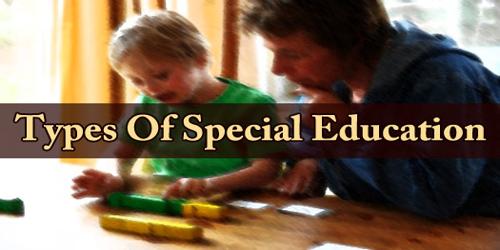Special Education (also known as special-needs education, aided education, exceptional education, special ed. or SPED), is a form of instruction that’s designed to meet the needs of students with disabilities so that they can learn the same skills and information as other children in school. The term special education is used interchangeably with special needs, and the disabilities may be physical, emotional, or behavioral.
Special education includes learning disabilities (such as dyslexia), communication disorders, emotional and behavioral disorders (such as ADHD), physical disabilities (such as osteogenesis imperfecta, cerebral palsy, muscular dystrophy, spina bifida, and Friedreich’s ataxia), and developmental disabilities (such as autistic spectrum disorders including autism and Asperger syndrome and intellectual disability) and many other disabilities. Students with these kinds of disabilities are likely to benefit from additional educational services such as different approaches to teaching, the use of technology, a specifically adapted teaching area, or a resource room.
Intellectual giftedness is a difference in learning and can also benefit from specialized teaching techniques or different educational programs, but the term “special education” is generally used to specifically indicate instruction of students with disabilities. Gifted education is handled separately.
The general philosophy of special education is that all people have the ability to learn, regardless of their particular disabilities. The trend in public education has shifted from isolating special education students in separate classrooms to mainstreaming them in the regular classroom for at least part of the day. This is in keeping with the U.S. Department of Education’s Office of Special Education and Rehabilitative Services (OSERS) mission to “…achieve full integration and participation in society of people with disabilities by ensuring equal opportunity and access to, and excellence in, education, employment, and community living.”
In most developed countries, educators modify teaching methods and environments so that the maximum numbers of students are served in general education environments. Therefore, special education in developed countries is often regarded as a service rather than a place. Integration can reduce social stigmas and improve academic achievement for many students.
The opposite of special education is general education. General education is the standard curriculum presented without special teaching methods or supports. Students receiving special education services can sometimes enroll in a General education setting to learn along with students without disabilities.
Types of Special Education –
Students needing special education include those with autism spectrum disorders, vision and hearing impairment, intellectual disability (functioning far below age levels), emotional disorders, specific learning disabilities related to reading or ability to do the math, and speech and language impairment.
Deaf-blindness: This refers to a student that has difficulties when it comes to both hearing and seeing what’s being said and shown to them. They may not be completely deaf or blind, but the combination of the two of these issues makes it harder for them to learn at the rate of their peers.
In some cases, they have struggled so much that a school dedicated specifically to only the deaf or only the blind did not have the resources to help them.
Hearing Impairment: A student with a hearing impairment may not be completely deaf, but they are hard of hearing. In some cases, they may be deaf in one ear or deal with a hearing loss that changes and progresses with time.
In short, it’s any loss or change in hearing that isn’t defined as deafness.
Deafness: A deaf child has many specific needs in the classroom. Parents may need to learn ASL, understand how to operate a hearing aid system, and find other ways to communicate with deaf students.
Specific Learning Disability: A child with a specific learning disability, or SLD, has been diagnosed with a processing or learning issue. They may have a single learning disability, or they may have more than one. This can make it hard for the child to read, communicate, write, understand math, and more.
Specific Learning Disabilities can include an auditory processing disorder, Dyslexia, a nonverbal learning disability, or Dysgraphia.
Autism: There are over 3.5 million Americans currently living on the Autism spectrum. Autism means that a child may have difficulty expressing or controlling their emotions, have trouble with communication, and even struggle to make friends. They may also make repetitive movements, fixate on ideas, and become extremely sensitive to their sensory surroundings (like light or sound.)
Other Health Impairment: This is a bit of an “umbrella term” when it comes to the types of special education available to learners today. This can refer to conditions and illnesses that impact a child’s strength, ability to focus or stay awake, and more.
For example, ADHD falls under the category of “Other Health Impairment.
Visual Impairment/Blindness: There are nearly 63,000 students who are either blind or dealing with another more severe visual impairment.
Be aware that a child who wears glasses will not fall under the category of Visual Impairment.
A student may require special accommodations; need help to learn braille, or even need a guide around their school.
Speech or Language Impairment: This is another blanket term in the world of special education. This means that a child has issues with speaking or communication. They may not speak the language of instruction, they may stutter, and they may have some sort of a voice impairment that prevents them from speaking.
Emotional Disturbance: A student with an emotional disturbance deals with moderate to severe mental health issues.
In some cases, they have been diagnosed with a more severe mood disorder, like Bipolar Disorder or even Borderline Personality Disorder. They may also have schizophrenia, extreme anxiety, or even obsessive-compulsive disorder. They may become angry, mean, or violent, or they may withdraw and isolate themselves to the extreme.
Traumatic Brain Injury: This type of special education refers to a student that has suffered from a brain injury that has impacted their physical and/or emotional/learning development.
Usually, this happened because of an accident. In some cases, however, the brain injury could have been sustained because of abuse.
Intellectual Disability: This refers to children that don’t simply have a learning disability but have an intellectual ability that is well below average for their age range.
For example, the student may have Down Syndrome.
In some cases, this lower intellectual level can make it hard for the student to take care of themselves. It could also impact their overall social life, and make it tough for them to communicate their needs and feelings.
Multiple Disabilities: In some cases, children will have more than one of the disabilities on this list. This means that parents may need to look into more specialized programs to ensure that their students get the education support they need.
Orthopedic Impairment: Students with an orthopedic impairment deal with situations that make it difficult for them to move as easily as children without some sort of disability can. They may be in a wheelchair, be missing a limb, need a walker, or have a limp or another issue that makes it harder for them to move. In some cases, they may be unable to write or fully turn their heads to read.
A special education program should be customized to address each student’s needs. Special educators provide a continuum of services, in which students with various disabilities receive multiple degrees of support based on their individual needs. It is crucial for special education programs to be individualized so that they address the unique combination of needs in a given student.
In the United States, Canada, and the UK, educational professionals use a student’s Individualized Education Program (IEP). Another name for a student’s Individualized Education Plan is a student’s Individual Learning Plan (ILP).
“The IEP is meant to address each child’s unique learning issues and include specific educational goals. It is a legally binding document. The school must provide everything it promises in the IEP.”
The World Conference on Special Needs Education: Access and Quality, held in 1994 in Salamanca, Spain, endorsed inclusive schooling on a worldwide basis. As a result of this conference, UNESCO was charged with promoting special education concerns among teachers, documenting progress in various regions and among different programs, and encouraging research in special-needs education. For the gifted, special programs of enrichment and acceleration are increasingly preferred to special classes. Resource rooms for those with sight or hearing impairments allow children to participate in regular classroom activities for part of the day. Older, educable persons with intellectual disabilities can be assigned to regular workshops, physical education classes, and other nonacademic classes. The eventual goal (beyond developing skills and imparting information) is to prepare these students for life in the larger society.
Information Sources:
















